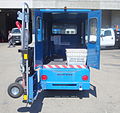2011 Ford E250 Cargo Owner Guide 3rd Printing - Page 113
2011 Ford E250 Cargo Manual
Page 113 highlights
Seating and Safety Restraints Transport Canada deactivation criteria (Canada Only) 1. Infant: An infant (less than 1 year old) must ride in the front seat because: • my vehicle has no rear seat; • the rear seat in my vehicle cannot accommodate a rear-facing infant seat; or • the infant has a medical condition which, according to the infant's physician, makes it necessary for the infant to ride in the front seat so that the driver can monitor the infant's condition. 2. Child age 12 or under: A child age 12 or under must ride in the front seat because: • my vehicle has no rear seat; • although children age 12 and under ride in the rear seat whenever possible, children age 12 and under have no option but to sometimes ride in the front seat because rear seat space is insufficient; or • the child has a medical condition that, according to the child's physician, makes it necessary for the child to ride in the front seat so that the driver can monitor the child's condition. 3. Medical condition: A passenger has a medical condition that, according to his or her physician: • poses a special risk for the passenger if the airbag deploys; and • makes the potential harm from the passenger airbag deployment greater than the potential harm from turning OFF the airbag and experiencing a crash without the protection offered by the airbag WARNING: This vehicle has special energy management safety belts for the driver and right front passenger. These particular belts are specifically designed to work with airbags to help reduce the risk of injury in a collision. The energy management safety belt is designed to give or release additional belt webbing in some accidents to reduce concentration of force on an occupant's chest and reduce the risk of certain bone fractures and injuries to underlying organs. In a crash, if the airbag is turned OFF, this energy management safety belt might permit the person wearing the belt to move forward enough to incur a serious or fatal injury. The more severe the crash, and the heavier the occupant, the greater the risk is. Be sure the airbag is turned ON for any person who does not qualify under the NHTSA deactivation criteria. 113 2011 Econoline (eco) Owners Guide, 3rd Printing USA (fus)
















